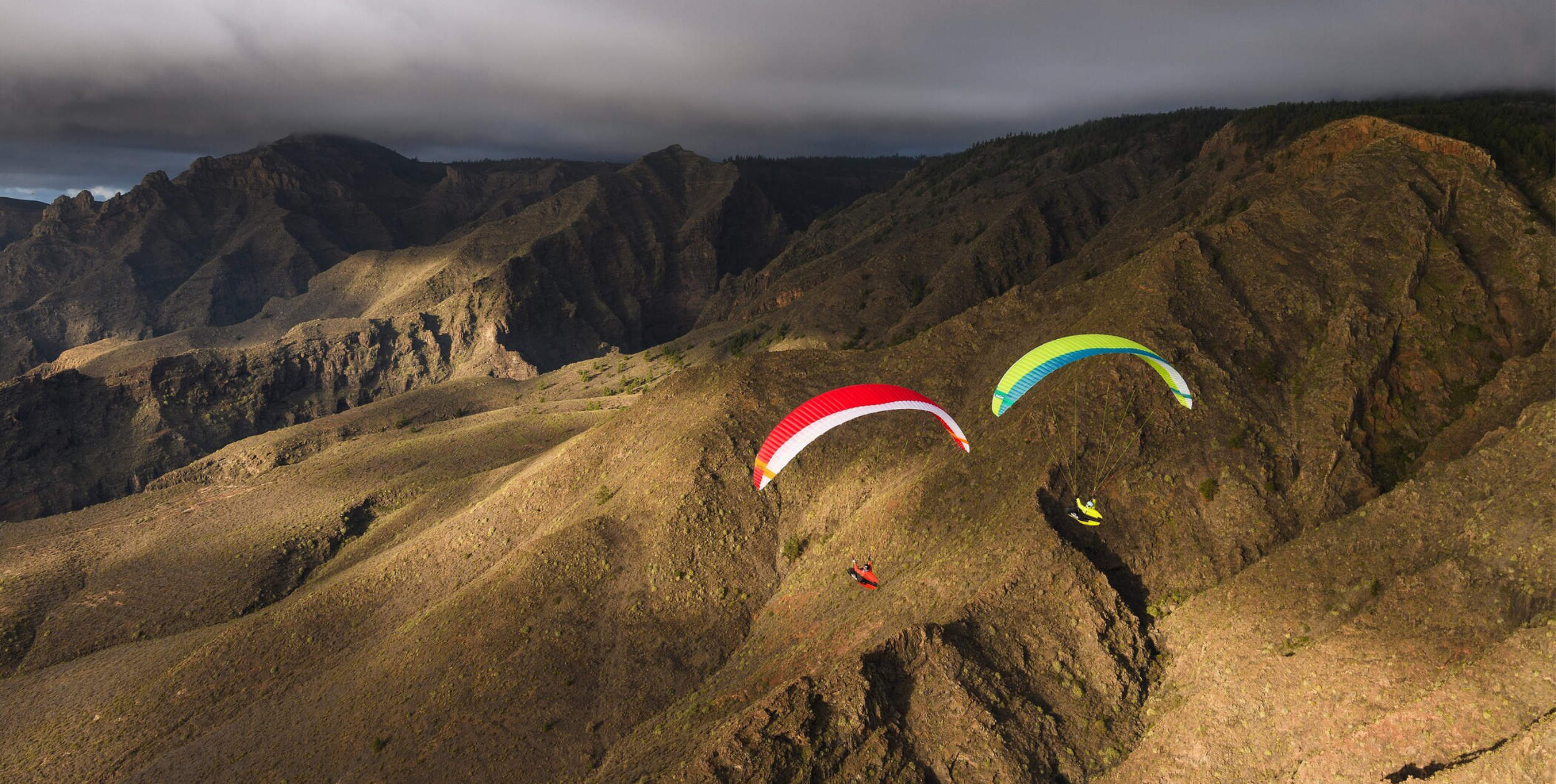By Bob Drury
I had expected the Edel Response, the new sports glider from Edel to be a replacement for the Saber; a solid DHV 2 wing. I was looking for bombproof, twitchless characteristics; I wanted a bog standard VW Golf Diesel, and no more. But when I ripped open the packaging, it looked like they had sent me the GTI model. Could a glider with the Response’s racey looks possibly be safe enough for what the Edel brochure quotes as “an experienced pilot with 75 hours airtime”? Two months later I think I have the answer.
The Response was conceived by long term Edel designer Gin Seok Song, and when he left the company earlier this year, the Response project was handed over to Urs Imhof. For those of you with experience of the Rainbow, Energy, Saber or Sector, your first impression will be that this is a very different wing from what you may have expected. Gone are the heavy brake pressures and floppy tips so characteristic of previous Edel performance models. Instead you’ll find a highly pressured and well balanced wing that responds better in roll and pitch.
Test Conditions
I’ve flown the Response for 40 hours. After some flying in the French Alps, I decided to take the Response with me during my recent vol bivouac trip in the Indian Himalaya in places where security is paramount. We then conducted the final tests in Gourdon, France, in November.
Construction
The Response is a fairly standard Edel bird in terms of materials; Toray 66 44g/m2 ripstop nylon, and Technora aramide kevlar lines. After 40 hours airtime (and many nights sleeping inside it!), our test Response shows no unusual signs of wear. Stitching quality is good, and the top surface is fairly clean, but the brake fan is a little unfinished giving rise to a slightly jagged trailing edge when the brakes are pulled. But, in short, the build quality is as good as you would expect from any aircraft made of nylon.
All 3 sizes have 19 triple cells, with line attachments either side. Each triple cell contains two diagonally braced cells sandwiching a central cell which contains a reinforcing brace connecting to the diagonal walls (see diagram). The lower 1.7 mm diameter lines split to an upper cascade of 1 mm lines, and there are 3As, 4Bs, 3Cs and 2Ds in the lower cascade.
The riser system is a standard fixed D set up, and allows you 14 cm of travel between A and D. It is progressive in the way it pulls each riser from the word go. There’s only a 2:1 pulley system, with the speed line running from the bottom of the riser up through a top pulled and then down to your bar. The advantage of this system over the more commonplace 3:1 two pulley arrangement is that you don’t have to extend your legs so farm but it makes for heavier bar pressure.
Following the age old tradition of releasing a fine glider in a far from fine bag, the latest sack from Edel looks cool,but load it up and go on a reasonable trek and your back and shoulder will soon be screaming for mercy. The heavily padded shoulder straps help, but the 3 cm wide unpadded waist band is a token gesture, not a functioning asset.
This said,the Edel bag is still a league ahead of many manufacturer’s offerings, but I’ve yet to see a truly comfortable and functional sack. I’ve heard that the reasoning for this is that the general public can’t get bulky bags into the backs of their harnesses, but that’s like not putting good tyres on your car because the spare wont fit in the trunk.
Handling
On the deck, the Response is as easy to launch as any other glider. It came up evenly and smoothly when reverse launched, and even with an over enthusiastic pull, it didn’t overshoot. The A risers are marked with red plastic inserts in the mallions, and are fairly easy to find when you’re being dragged around on take off. Front launching was equally easy, and provided the glider is laid out well, it inflated evenly giving good internal pressure immediately.
In the air was where the real surprises lay. Edel’s Response lives up to its name, handling better than any of it’s predessors. It maintained a steady angle of bank with surprising little effort. The braking was much lighter than had I expected but still progressive enough to mean the spin point didn’t sneak up on you. In fact the spin arrived with a bang, like snapping a plank of wood.
You’d have to be pretty clumsy not to notice it. Feedback in flight was good, as the wing is well pressured and the brake pressure was still tight enough that I felt very involved with what was going on upstairs.
Thermalling the Response in light lift was lovely. Smooth and well coordinated, the wing turned flatly with brake alone and didn’t need the high angle of roll I associated with the early Sectors and Saber. Taking her into the roughest of climbs in the Himalayas, it was great to know there was is also enough energy in the wing to bank it up and screw my way out of trouble.
A new and much needed tool to Edel’s box is the Response’s yaw characteristics. Much improved from previous Edel wings, the Response allows you to confidently release the outside brake when thermalling without the outer tip accelerating too much and folding. The sight of yet another tip closure used to drive me mad whilst trying to thermal 1997 Sector and Saber, but the Response has shed this unwanted trademark.
Whilst testing in Gourdon, I had to put the Response down in loads of tight spots. The well defined stall point let me mush the glider in to a garden allotment on one occasion and a 5 a side football pitch on another, both results of over-zealous glides into a strengthening valley wind. Top landing the rocky launch area was made easier by this ‘mush-ability’.
Performance
Hands up, the Response is trimmed at 37 kph, and its speed range within the brake travel is good. I never had a problem slowing it down and scratching with other gliders. The sink rate seems adequate: if you’re outclimbing other gliders it’s probably the excellent handling that’s aiding your ascent.
The Response accelerates smoothly away through the initial part of the bar’s travel, but then beyond half bar it gains only a smidgeon more speed. On my first full-bar experience with the factory risers fitted, I actually thought I was only using half bar till I checked and saw the pulley down to the knot.
Obviously the reason for limiting the travel on the factory risers is safety, as part of the DHV test is the dreaded accelerated assymetric collapse: full speed bar on, tug in an A riser and hang on to your hat. It’s every manufacturer’s nightmare, and often their stumbling block, as all gliders go bananas when you do it. However it does simulate severe full speed deflations and is always one of the most important tests to check.
Our measurements, taken early in the morning in calm air above Gourdon, gave a top accelerated speed of 44 kph; a speed range of only 7 kph with the bar. This leads me to believe that the speed system has been tempered down to get it through the tests. This is nothing unusual, but is a bit of a shame for those of us who often want to charge across the sky flat out on full bar. You’re going to have to find your winning edge from your flying skills rather than the accelerator.
Security
Despite the high aspect and thin profile, the Response was incredibly resistant to deflations and surging. Any glider was going to be a handful at 6000 m in the Himalayas, but despite a bombardment of feedback and violent, I never took the full pasting I expected. The glider cut through dirty air in a solid manner. The drawback to sails with this amount of resistance to deflations is that when they do collapse they go big time. Load the Response to the gunnels, hit some evil air, and you might well be whipped round 180 degrees before you sort it out.
A combination of the Response’s line arrangement and high internal pressure meant that breaking the leading edge to get into big ears is harder than I’m used to. The tip line arrangement means that your efforts are concentrated further away from the tip than normal but also means that when the ears come in you get a good 40% of the glider closed immediately. At first the glider rolls around, but soon settles down to steady level flight.
B lining was a physically demanding task. There’s so much internal pressure that stalling it across the span is no mean feat. Lighter pilots might well find themselves hanging uselessly from the risers with the glider seemingly oblivious to their efforts. The Response is the tautest glider I’ve ever B lined, but when I got it to stall the descent was safe and stable depite the high aspect ratio of the wing.
Spiral dives were really easy to initiate and you can be pulling several Gs within a couple of rotations. The Response pulls out easily and showed no sign of locking in and charging groundwards out of control. Again, the well defined spin point should stop the heavy handed pilots out there going negative on entry.
In August, I took the Response out over the lake at Annecy and gave it a good working. Full frontal symmetrical deflations were in and out in seconds and pulling an A riser at normal trim speed didn’t turn me more than 90 degrees. Wanting to simulate some real violence, I dropped the glider back to stall point and let it dive right down in front of me before giving the A riser a quick yank. As expected all hell broke loose. I gave it the usual amount of input, i.e. lots, but the glider cravatted and began to rotate quickly before I stalled it out.
Is this a problem I hear you all asking… In my opinion, cravatting is a sign of the times, and is a problem inherent in most of today’s performance wings. The quest for less line drag has meant greater spacing between each line, and it is far easier for wing tips to violently fold in, catch in a line cascade, and cravatte.
This is more a reflection on the characteristics of performance wings when pushed to the limit than a comment particular to the Response. Indeed, I’ve heard of a Greek pilot who was astonished that after pulling in a big assymetric, his brand new DHV 2/3 glider immediately cravatted, spiraled and he threw his rescue.
After simulating such a savage deflation, the Response was stable in full stall and the surge on release controllable.
In Summary
The Response is a beautifully handling performance glider that shows a high resistance to deflations and is a pleasure to fly. The feedback in flight is excellent although the limit in accelerated speed might leave some competition pilots wanting more. With the current performance available from DHV 1-2 & 2 gliders the Response is an unnessary purchase for the weekend pilot. It is a beautiful machine for the passionate, active pilot who wants to push his or her XC limits further without taking on the unnecessary dangers inherent in full blown competition weapons.
The Reviewer
Bob Drury has been flying since 1993, and regularly tests gliders. He was 4th in this year’s British Nationals, and has completed two vol bivouac expeditions in the Indian Himalayas. He has owned a UP Flash, Nova Sphinx, Edel Energy and Sector over the years, and prefers moderate brake pressures and lots of feedback to light brake pressures. This review is a subjective evaluation based on Bob’s own experience and findings. Bob is loaned gliders and equipment by Edel UK. The performance tests were measured on a Response M with a Skywatch Pro set to an averager of 6 seconds. The all up weight was 92 Kg, flying at 1000 m asl at Gourdon on 13/11/98, in calm air to allow safe acceleration. Accurate speed readings are notoriously difficult to acheive, and readers should be aware that 5 -10 % inaccuracy can occur.
This review appeared in Cross Country magazine issue 60.








